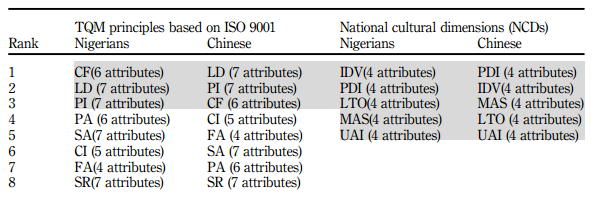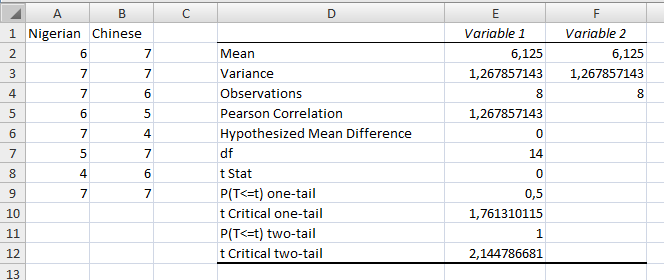Executive Summary: Improving Quality Through Motivation and Upskilling
Focusing on quality improvement is essential in the context of a multicultural corporation. The introduction of the Six Sigma DMAIC framework was tested as a possible tool for carrying out the improvements. The use of the one-sample t-test as the tool for verifying the hypothesis made it quite clear that there is an evident difference between the performance rates and the number of defects omitted. Therefore, the adoption of the DMAIC framework must be viewed as imperative in the environment of the global economy and the collaboration between a Nigerian and a Chinese company.
Goals: Locating the Strategy for Performance Improvement
At present, the construction industry needs a major and a rather rapid upgrade in the quality of the products provided to the customers (Tabassi, Ramli, & Baccar, 2012). Despite the overall success that the Nigerian and the Chinese firms have been enjoying so far, the security of the products needs to be enhanced, and the number of defects per item will have to be reduced. It is hypothesized that the number of the cultural attributes considered correlates with the differences in staff’s performance framework suggested by is likely to reduce the number of defects. The goal of the paper is to test the hypothesis above.
Scope Statement: What Has Been Encompassed
The study revolves around the analysis of the correlation between the TQM principles that needed to be adopted in the context of the Nigerian and Chinese organizations and the number of national and cultural dimensions that needed to be taken into account to improve the product quality (Meyer, 2014).
Assumptions: What May Spin out of Control
One must admit that the external factors affecting the performance rates of the staff members are not fully addressed in the study. Instead, the focus is primarily on the cultural aspects of the team members’ functioning. Therefore, it could be argued that other types of motivation enhancement should be considered in the context of the company (Burris, Detert, & Romney, 2013).
Data Collection: Retrieving Essential information
The data was collected of considering the scholarly articles published at Emerald Insight. Particularly, the article by Babatunde and Pheng (2015) was used as the primary source of retrieving information required to carry out the analysis. The focus on the specifics of cross-cultural communication in Babatunde and Pheng’s (2015) article allows identifying the efficacy of the framework.
Data Analysis: Locating the Key Tendencies in the Staff Performance
To figure out whether there is any tangible correlation between the number of the TQM attributes (Figure 1) used to improve the current state of affairs and the cultural dimensions to be addressed, the t-test framework was used (Groebner, Shannon, & Fry, 2014).

The null hypothesis states that the number of attributes does not have any effect on the differences in performances between the groups (Herkenhoff & Fogli, 2013). The alternative hypothesis states that there is considerable variability.
Data Results: Description and Implications
Based on the results of the test (Figure 2), it can be assumed that the outcomes retrieved cannot be deemed as statistically significant. In other words, the null hypothesis implying that there is no difference between the two groups in question can be rejected.

Therefore, the application of the strategies aimed at addressing cross-cultural issues does not depend on the number of national cultural dimensions to be encompassed (Pyzdek & Keller, 2014).
Reference List
Babatunde, Y., Pheng, L. S. (2015). TQM implementation through ISO 9001: findings from Chinese construction firms in Nigeria. The TQM Journal, 27(6), 1754-2731. Web.
Burris, E. R., Detert, A. R., & Romney, R. C. (2013). Speaking up vs. being heard: The disagreement around and outcomes of employee voice. Organization Science, 24(1), 22–38. Web.
Groebner, D. F., Shannon, P. W., & Fry, P. C. (2014). Business statistics: A decision-making approach (9th ed.). Upper Saddle River, NJ: Prentice Hall.
Herkenhoff, L., & Fogli, J. (2013). Applied statistics for business and management using Microsoft Excel. New York, NY: Springer.
Meyer, E. R. (2014). The culture map: Breaking through the invisible boundaries of global business. New York, NY: PublicAffairs.
Pyzdek, T., & Keller, P. (2014). The Six Sigma handbook. Upper Saddle River, NJ: Prentice Hall.
Tabassi, A. A., Ramli, M., & Baccar, A. H. A. (2012). Effects of training and motivation practices on teamwork improvement and task efficiency: The case of construction firms. Effects of training and motivation practices on teamwork improvement and task efficiency: The case of construction firms. International Journal of Project Management, 30(2), 213-224. Web.